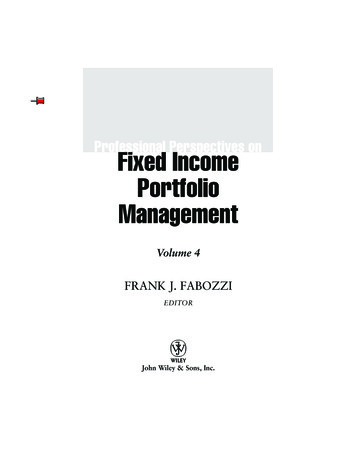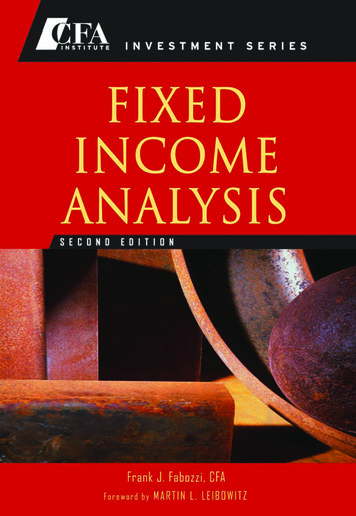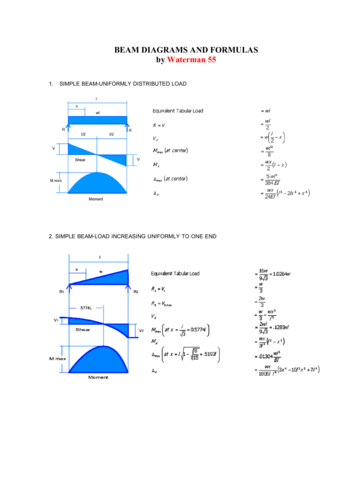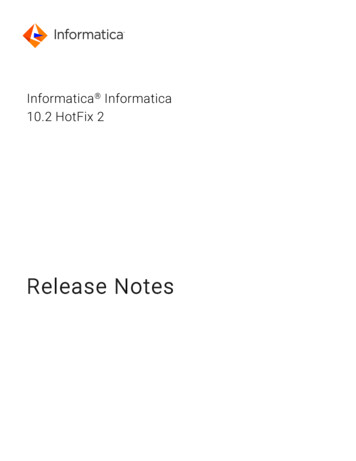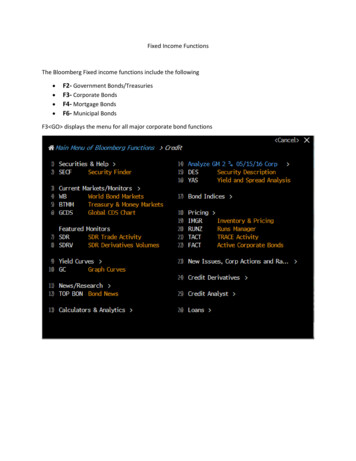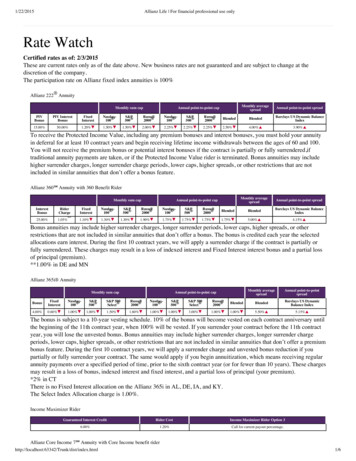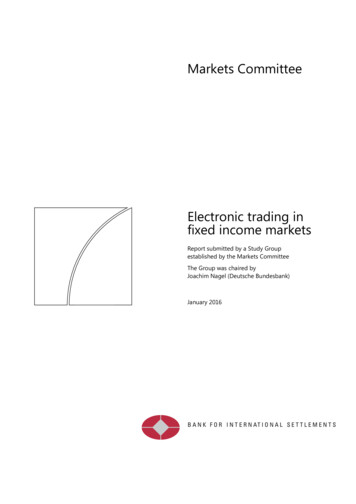
Transcription
Markets CommitteeElectronic trading infixed income marketsReport submitted by a Study Groupestablished by the Markets CommitteeThe Group was chaired byJoachim Nagel (Deutsche Bundesbank)January 2016
This publication is available on the BIS website (www.bis.org). Bank for International Settlements 2016. All rights reserved. Brief excerpts may bereproduced or translated provided the source is stated.ISBN 978-92-9197-420-7 (online)
PrefaceElectronic trading has become an increasingly important part of the fixed incomemarket landscape in recent years. It has contributed to changes in the marketstructure, the process of price discovery and the nature of liquidity provision. Therise of electronic trading has enabled a greater use of automated trading (includingalgorithmic and high-frequency trading) in fixed income futures and parts of cashbond markets. Innovative trading venues and protocols (reinforced by changes inthe nature of intermediation) have proliferated, and new market participants haveemerged. For some fixed income securities, “electronification” has reached a levelsimilar to that in equity and foreign exchange markets, but for other instruments thetake-up is lagging.Against this background, in January 2015 the Markets Committee established aStudy Group on electronic trading in fixed income markets (chaired by JoachimNagel, Deutsche Bundesbank) to explore how ongoing developments are affectingmarket structure and functioning.This report presents the Group’s findings. It is based on information from arange of sources, including structured interviews with market participants and asurvey of electronic trading platforms. It argues that advances in technology andregulatory changes have significantly affected the economics of intermediation infixed income markets and that electronification is changing the behaviour ofinvestors. The rise of electronic trading is creating efficiencies for many marketparticipants, improving market quality in normal times, lowering transaction costsand reducing market segmentation, while at the same time posing challenges tosome participants. Electronic trading, in particular automated and high-frequencytrading, also poses a number of challenges to policymakers, including the need tomonitor its effect on market liquidity and functioning and to ensure appropriategovernance of automated trading. The report identifies a number of core areas forfurther policy assessment.The report is a timely and important contribution to the ongoing discussionsabout the quality of market functioning and its implication for market design.Guy DebelleChair, Markets CommitteeAssistant Governor, Reserve Bank of AustraliaMC – Electronic trading in fixed income marketsiii
ContentsExecutive summary . 11. Introduction . 32. What is electronic trading and how has it evolved? . 42.1 What do we mean by “electronic trading”? . 42.2 How has electronic trading evolved in fixed income markets? . 4The voice era: an over-the-counter (OTC) market with dealers atits core . 4The rise of electronic trading in the inter-dealer market . 5The rise of electronic trading in the dealer-client segment . 6Automated trading and the rise of new market-makers. 7Box 1: What are automated trading and high-frequency trading? . 83. What is the current state of electronic trading in fixed income markets? . 8Fixed income futures . 9Box 2: Key drivers of electronic trading . 10Sovereign bond markets . 10Interest rate swaps. 12Corporate bonds . 12A survey of electronic trading platforms . 134. Impact of electronic trading . 154.1 Impact on infrastructure and the market ecosystem . 15Platform innovation and competition. 15Evolving trading conventions . 164.2 Impact on market participants. 16Suppliers of intermediation . 16Box 3: Dealers as intermediaries: principal vs agent . 18Demanders of intermediation . 194.3 How does electronic trading affect market quality? . 20Impact of platform trading. 20Box 4: Market quality . 21Impact of ultra-fast traders on market quality . 22MC – Electronic trading in fixed income marketsv
Automated trading in bond markets . 23Impact of electronification in fixed income markets – suggestiveevidence . 23Further insights from other asset classes and various case studies . 255. Challenges for policy. 265.1 Data, disclosure and monitoring . 265.2 Market quality and stability . 275.3 Risks and risk management . 275.4 Trading practices and regulation . 28Appendix A: Study Group mandate . 31Key Questions Stage 1. Trends and drivers . 31Key Questions Stage 2. Potential implications for market functioning . 31Process . 32Appendix B: Impact of automated trading – insights from other asset classes . 33Appendix C: Case studies . 35The US Treasury market on 15 October 2014 . 35The bund tantrum of May–June 2015. 36Gyrations in JGB futures markets . 37References . 39Glossary . 42Members of the Study Group . 44viMC – Electronic trading in fixed income markets
Executive summaryElectronic trading in fixed income markets has been growing steadily. In manyjurisdictions, it has supplanted voice trading as the new standard for many fixedincome asset classes. Electronification, ie the rising use of electronic tradingtechnology, has been driven by a combination of factors. These include: (i) advancesin technology; (ii) changes in regulation; and (iii) changes in the structure andliquidity characteristics of specific markets. For some fixed income securities,electronification has reached a level similar to that in equity and foreign exchangemarkets. US Treasury markets are a prime example of a highly electronic fixedincome market, in which a high proportion of trading in benchmark securities isdone using automated trading. However, fixed income markets still lagdevelopments in other asset classes due to their greater heterogeneity andcomplexity.This report highlights two specific areas of rapid evolution in fixed incomemarkets. First, trading is becoming more automated in the most liquid andstandardised parts of fixed income markets, often importing technology developedin other asset classes. Traditional dealers too are using technology to improve theefficiency of their market-making. And non-bank liquidity providers are searchingfor ways to trade directly with end investors using direct electronic connections.Second, electronic trading platforms are experimenting with new protocols to bringtogether buyers and sellers.Advances in technology and regulatory changes have impacted theeconomics of intermediation in fixed income markets. Technologyimprovements have enabled dealers to substitute capital for labour. They are able toreduce costs by automating quoting and hedging of certain trades. Dealers are alsoable to better monitor the trading behaviour of their customers and how their orderflow changes in response to news. Dealers are internalising flows more efficientlyacross trading desks, providing greater economies of scale for trading in securitieswhere volumes are particularly high. But the growth in electronic trading is posing anumber of challenges for traditional dealers. It has allowed new competitors withlower marginal costs to reduce margins and force efficiency gains, and it hasrequired a large investment in information technology at a time when traditionaldealers are cutting costs.Electronification is also changing the behaviour of buy-side investors. Theyare deepening their use of execution strategies, in particular complex algorithms.Large asset managers are further internalising flows within their fund family. And anumber of asset managers are supporting different competing platform initiativesthat are attempting to source pools of liquidity using new trading protocols.Electronic trading tends to have a positive impact in terms of marketquality, but there are exceptions. There is relatively little research specific to fixedincome markets, but lessons can be drawn from other asset classes. Evidencepredominantly suggests that electronic trading platforms bring advantages toinvestors by lowering transaction costs. They improve market quality for assets thatwere already liquid by increasing competition, broadening market access andreducing the dependence on traditional market-makers. But platforms are not theappropriate solution for all securities, particularly for illiquid securities for which therisks from information leakage are high. For these securities, there is still a role forbilateral dealer-client relationships.MC – Electronic trading in fixed income markets1
The impact of automated and high-frequency trading is a matter ofconsiderable debate. Studies suggest that automation results in faster pricediscovery and an overall drop in transaction costs (at least for small trade sizes). Theentrance of principal trading firms with lower marginal costs than traditionalmarket-makers has intensified competition.It remains to be seen whether the benefits of automation observed in normaltrading periods also prevail during periods of stress, when the benefits ofimmediacy are particularly high. Competition over speed might displace traditionalbroker-dealers who may be more willing to bear risks over longer horizons. There isa risk that liquidity may have become less robust and prices more sensitive to orderflow imbalances. Some recent episodes covered in this document shed some lighton these issues. These episodes highlight that multiple drivers are likely to be atplay, rather than conclusive evidence pointing to a predominant impact ofautomated trading alone.Electronic trading, and in particular automated trading, poses a number ofchallenges to policymakers. The appropriate response may differ acrossjurisdictions because of the heterogeneous nature of fixed income markets as wellas the varying degrees of electronification.The report identifies four core areas for further policy assessment: First, the steady advance of electronic trading needs to be appropriatelymonitored. Access to better data is required. A supplement to bettermonitoring is to establish regular dialogue between regulatory bodies andindustry participants. Second, further investigation is required to gauge the impact of automatedtrading on market quality. While there has been an improvement in certainmetrics, liquidity may have become more fragile during stress episodes. Moresophisticated measures need to be used to capture the multiple dimensions ofmarket quality. Third, electronification has created additional challenges for risk managementat market-makers, platform providers and end investors. Algorithm developersshould follow guidelines for best practices. Policymakers should be consciousof the growing dependence on critical electronic trading infrastructures. Fourth, regulation and best practice guidelines should be living documents.They should be repeatedly reviewed and adapted as markets evolve. It may alsobe worth considering whether current regulatory requirements contribute to alevel playing field amid the changing market structure and/or whether, forexample, a code of conduct applicable to all significant market participants maybe appropriate, when warranted by the specific circumstances.When responding to these challenges, regulators should strike a balancebetween prescription and room for healthy innovation in market design. A flexibleapproach can enable platforms to compete to discover new ways to increaseefficiency and integrity.2MC – Electronic trading in fixed income markets
1. IntroductionElectronic trading has become an increasingly important part of the fixed incomemarket landscape in recent years.1 The rise of electronic trading has enabled apickup of automated trading (including algorithmic and high-frequency trading) infixed income futures and parts of cash bond markets. Innovative trading venues andprotocols (reinforced by changes in the nature of intermediation) have proliferated,and new market participants have emerged. These recent changes have resulted ina transformation of the fixed income market structure, the process of pricediscovery and nature of liquidity provision. Electronic trading is advancing amidthese structural changes, while implications for market quality and functioning areyet to be fully explored.This report provides a view of the rising use of electronic and automatedtrading in fixed income and related derivatives markets – a process we refer to as“electronification”. The primary goal of the report is to take stock of thisdevelopment and to assess how electronification may be affecting market structureand quality. It is concerned with the impact of increasingly sophisticated andautomated trade order and execution technologies. And, it takes a detailed look atthe new challenges for policymakers.The remainder of this report is structured as follows: Chapter 2 sets the stage, by providing a definition of electronic trading anddescribing its evolution in fixed income markets from a historical perspective. Italso introduces key concepts and provides a categorisation of different tradingstyles, venues and protocols. Chapter 3 provides an overview of the current state of electronic trading. Toderive its main conclusions, the chapter draws on an extensive series ofinterviews with market participants and provides quantitative figures from asurvey conducted among electronic trading platforms geared towards fixedincome. Chapter 4 looks at the broader impact of electronic trading. It discusses howelectronification alters the market ecosystem, as well as the behaviour ofdifferent players that supply or demand intermediation services. Also, theimpact of electronification on market quality is discussed. Chapter 5 outlines the challenges for policymakers at the current juncture.A separate glossary is provided at the end of the report.1Electronic trading in fixed income markets still remains less prominent compared with other assetclasses, though. A key factor for the slower adoption of electronic trading in fixed income has beenthe greater complexity of the asset class (eg different coupons, maturities, embedded options,covenants) and the resulting higher degree of fragmentation.MC – Electronic trading in fixed income markets3
2. What is electronic trading and how has it evolved?2.1 What do we mean by “electronic trading”?The term “electronic trading” covers a variety of activities that are part of the lifecycle of a trade. In this report, electronic trading refers to the transfer of ownershipof a financial instrument whereby the matching of the two counterparties in thenegotiation or execution phase of the trade occurs through an electronic system.Electronic trading broadly covers: trades conducted in systems such aselectronic quote requests, electronic communications networks or dealer platforms;alternative electronic platforms such as dark pools; the quotation of prices or thedissemination of trade requests electronically; and settlement and reportingmechanisms that are electronic. For example, this includes both high-frequencytrading on exchanges and trades negotiated by voice but executed and settledelectronically.The electronification of all these aspects of fixed income trading has beensteadily increasing. There are now a variety of electronic trading platforms (ETPs),systems that match buyers with sellers, that differ in terms of the composition oftheir clients and their trading protocols.2.2 How has electronic trading evolved in fixed income markets?The voice era: an over-the-counter (OTC) market with dealers at its core2Traditionally, fixed income trading has been organised around dealers (large banksor securities houses) and their relationship-based networks of clients. A physicallycentralised marketplace or organised exchange has generally been absent.3 Dealerspredominantly traded bilaterally via the telephone, either with other dealers or withtheir customers. The process of matching buyers and sellers required a fair amountof intermediation and involved significant search costs (Duffie (2012)). A customerwishing to trade a specific security would often contact one or more dealers byphone, asking for currently available prices to buy and sell. This market structure isknown as a quote-driven market, a market in which executable prices are offered inresponse to counterparties’ requests to trade.The fixed income market has historically been marked by a segmentationbetween the inter-dealer segment, in which dealers trade with one another, and thedealer-customer segment, in which dealers trade with their clients (eg assetmanagers, pension funds, insurance companies, corporations). In other words, endusers do not trade directly with other end users (Graph 1, left-hand panel). In the2BIS (2001) describes the pickup in electronic trading in foreign exchange and fixed income marketsin the late 1990s. Mizrach and Neely (2006) provide an insightful discussion of the first stages ofelectronification in US Treasury markets. Other earlier surveys that provide a discussion of theevolution of trading in fixed income markets include Hendershott (2003) and Fleming et al (2014).3Historically, however, bonds in the United States were once traded on the New York StockExchange (NYSE). Corporate bond trading on the NYSE was still fairly active until the late 1940s,before migrating to OTC markets (Biais and Green (2007)).4MC – Electronic trading in fixed income markets
inter-dealer market, dealers traditionally traded either bilaterally over the phone ormultilaterally (and anonymously) via voice brokers.Bond trading has also generally been somewhat more opaque than trading inother asset classes. Details of a deal are often known only by the counterparties,and price or volume information is not disseminated to the wider investing public.Due to the market’s segmentation, quotes and trade prices for the same bond atthe same time could vary greatly across dealers.How bond market structure has evolvedGraph 1Traditional market structureHow bond markets have Principaltrading ler-customermarketCustomerMDP multi-dealer platform; SDP single-dealer platform.The rise of electronic trading in the inter-dealer marketFixed income markets experienced a major shift starting in the late 1990s aselectronic communication networks (ECNs) started to gain traction in inter-dealermarkets for liquid sovereign bonds. An ECN is a system that electronically matchesbuy and sell orders for securities. ECNs operate as virtually centralised marketplaces,aggregating offers to trade and matching them against incoming trade requests. Incontrast to the dealer-client markets, which were quote-driven, these platformswere generally order-driven. An order-driven market is a market in which executableprices are offered in advance of any requests to trade.ECNs often use the trading protocol of the central limit order book (CLOB). ACLOB is a trading protocol in which outstanding bids and offers by marketparticipants are stored in a queue and must be executed in a priority sequence. Inthe inter-dealer market, CLOBs are often pre-trade transparent to participants, inthe sense that any ECN member may view the set of bids and offers at which onecan sell or buy, respectively, at any time. Moreover, many ECNs enabled anonymoustrade subject to pre-defined limits on their order books. Transaction prices andvolumes were often disclosed post-trade. Another key advantage of the ECNs wasthe automated processing and settlement of trades, so-called straight throughprocessing (STP).An example of an ECN is EuroMTS, which is a pan-European platform forbenchmark sovereign bonds, agency bonds, and repos among other asset classes. ItMC – Electronic trading in fixed income markets5
was launched in 1998 to address the need to integrate European sovereign bondtrading under the common currency without altering the pre-existing close tiesbetween dealers and sovereign issuers.4 Likewise, eSpeed and BrokerTec for USTreasury securities both launched in 1999 and emerged as major inter-dealertrading venues for benchmark US government securities. In Japan, the electronictrading platforms BB Super Trade and Tri-Trade launched in 2000 and 2006,respectively. These platforms serve as electronic trading venues for inter-dealerJapanese government bond (JGB) markets.After the early 2000s, electronic trading infrastructure debuted in many otherjurisdictions, including emerging market economies, with some exceptions. Inmarkets such as Brazil, India, Korea and Singapore, electronic inter-dealer marketsfor sovereign bonds successfully developed with the benefit of public sectorsupport: Selic in Brazil, NDS-OM in India, KTS in Korea and E-bond in Singapore.Voice brokering continues to dominate in jurisdictions such as Hong Kong andMexico.The rise of electronic trading in the dealer-client segmentElectronic trading grew in the dealer-client market in the late 1990s and took twoforms: single-dealer platforms (SDPs) and multi-dealer platforms (MDPs). SDPs areproprietary trading systems offered by a single dealer to its customers. Trading viaSDPs can essentially be seen as an electronic version of the bilateral dealer-clientmarket. Multi-dealer platforms (MDPs) also emerged in the late 1990s. MDPsreduced search costs by allowing end investors to request quotes to trade from anumber of dealers simultaneously. MDPs also automated record-keeping, making iteasier to audit best execution.Dealer-to-client platforms are typically based on the request for quote (RFQ)trading protocol. An RFQ is a protocol in which platform users may query platformmarket-makers to request prices on an order of a particular size. RFQ systems rangea great deal in terms of: whether the quote requester or quote receiver reveals itsidentity; whether the sign of the order (buy or sell) is revealed; how many and whatkind of participants may receive RFQs; and whether the quotes are executable orindicative. In most fixed income RFQ systems, clients query only dealers and only inlimited numbers.A major landmark was the launch of Tradeweb in 1998. The firm is majorityowned by Thomson Reuters, with stakes held by 11 banks that also serve as keyliquidity providers on the platform. Other major multi-dealer platforms includeBondVision, introduced in 2001 (later acquired by MTS), and Bloomberg. Thesedevelopments led to a more diverse market structure (Graph 1, right-hand panel).Today’s market features greater connectivity among market participants, moretransparency and a greater variety of opportunities to trade.46In fact, MTS had been an innovation promoted by the Italian Treasury and the Bank of Italy as atrading venue for Italian Treasury securities. In 1997, MTS was privatised, the coverage wasexpanded and MTS transformed itself into the main inter-dealer venue for European sovereignbonds. In 2007, MTS was acquired by the London Stock Exchange.MC – Electronic trading in fixed income markets
Taxonomy of trading styles, platforms and protocolsGraph 2Electronic tradingAutomated tradingHighfrequencytradingAT automated trading; CLOB central limit order book; CTT click-to-trade; ECN electronic communication network; ET electronictrading; HFT high-frequency trading; MDP multi-dealer platform; RFQ request for quote; SDP single-dealer platform.Automated trading and the rise of new market-makersThe rise of electronic trading platforms enabled automated trading (AT) – acommon feature in other asset classes for more than a decade – to becomeprevalent in certain segments of fixed income markets. AT is a trading technology inwhich order and trade decisions are made electronically and autonomously(Graph 2, left-hand panel). A notable form of AT is high-frequency trading (HFT),which relies on speed and tight intraday inventory positions. A closer look at AT andHFT is presented in Box 1.The presence of new market participants pursuing AT/HFT strategies – labelledin this report as principal trading firms (PTFs) – is affecting the nature of liquidityprovision and intermediation in fixed income markets. Even traditional marketparticipants have invested in AT technology in recent years. Liquid sovereign bondmarkets (especially benchmark US Treasuries) have seen a significant rise in ATactivity. Traditional inter-dealer platforms such as BrokerTec and eSpeed havegranted access to PTFs, which generate large trading volumes. Recent estimatessuggest that over 50% of trading volumes in benchmark US Treasury securities onformerly exclusive inter-dealer venues can be accounted for by PTFs (US Joint StaffReport (JSR) (2015)).The most advanced AT and HFT strategies thrive in markets with CLOBs thatwere fairly liquid even before algorithmic trading, such as futures and benchmarksovereign debt. HFT strategies require a capacity to: generate a large number oforders, ensure that open positions are held for short periods (often seconds or less),and cancel a large share of orders that they generate (often over 80%).By contrast, trading protocols such as RFQ are amenable only to AT strategiesin which speed is less critical, such as auto-quoting and trade execution. An RFQsystem does not present algorithms with a continuous market. It should be nosurprise that less liquid bond market segments, such as the markets for nonbenchmark sovereign bonds or corporate bonds where CLOBs are not the commontrade protocol, do not see much HFT and only limited AT.MC – Electronic trading in fixed income markets7
Box 1What are automated trading and high-frequency trading?Automated trading (AT) is a trading technology in which order and trade decisions are made electronically andautonomously (BIS (2011)). High-frequency trading (HFT) is a subset of AT in which orders are submitted and tradesexecuted at high speed, usually measured in microseconds, and a very tight intraday inventory position ismaintained. HFT strategies seek to gai
Electronic trading has become an increasingly important part of the fixed income market landscape in recent years.1 The rise of electronic trading has enabled a pickup of automated trading (including algorithmic and high-frequency trading) in fixed income futures and parts of cash bond markets. Innovative trading venues and

